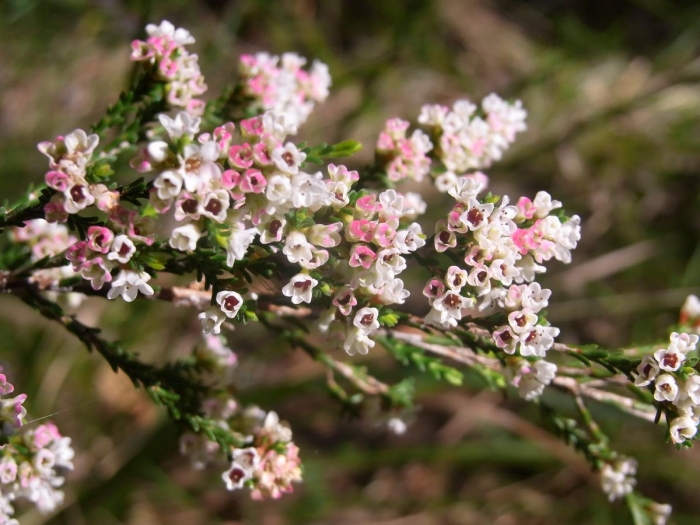Fringed Heath-Myrtle
(Micromyrtus ciliata)
Fringed Heath-Myrtle (Micromyrtus ciliata)
/
/

Poyt448 Peter Woodard
CC BY-SA 3.0
Image By:
Poyt448 Peter Woodard
Recorded By:
Copyright:
CC BY-SA 3.0
Copyright Notice:
Photo by: Poyt448 Peter Woodard | License Type: CC BY-SA 3.0 | License URL: https://creativecommons.org/licenses/by-sa/3.0 | Uploader: Poyt448 | Publisher: Wikimedia Commons | Title: Micromyrtus_ciliata_Dee_Why.jpg |

















Estimated Native Range
Summary
Micromyrtus ciliata, commonly known as Fringed Heath-Myrtle, is an evergreen shrub native to heathlands, coastal scrub, and open eucalypt forests in Eastern Australia. It typically grows to a height of 2-3 feet (0.6-0.9 meters) and a width of 3-4 feet (0.9-1.2 meters). This compact shrub has fine, needle-like foliage and a dense, rounded form. It produces an abundance of small, fringed flowers that can be white, pink, or red, blooming profusely in spring and summer, which are quite showy and attract pollinators.
Fringed Heath-Myrtle is valued for its ornamental flowers, low maintenance requirements, and its ability to adapt to a variety of garden settings. It is commonly used for border planting, as a ground cover, or in rockeries. It thrives in full sun to part shade and prefers well-drained soils, tolerating both sandy and loamy substrates. While it appreciates medium amounts of water, it is also known for its drought tolerance once established. There are no major disease issues, but it can be sensitive to root rot if overwatered or planted in poorly drained soils. Pruning after flowering encourages a bushier growth habit and more prolific blooms in the following season.CC BY-SA 4.0
Fringed Heath-Myrtle is valued for its ornamental flowers, low maintenance requirements, and its ability to adapt to a variety of garden settings. It is commonly used for border planting, as a ground cover, or in rockeries. It thrives in full sun to part shade and prefers well-drained soils, tolerating both sandy and loamy substrates. While it appreciates medium amounts of water, it is also known for its drought tolerance once established. There are no major disease issues, but it can be sensitive to root rot if overwatered or planted in poorly drained soils. Pruning after flowering encourages a bushier growth habit and more prolific blooms in the following season.CC BY-SA 4.0
Plant Description
- Plant Type: Shrub
- Height: 2-3 feet
- Width: 2.5-3.5 feet
- Growth Rate: Moderate
- Flower Color: White, Pink, Red
- Flowering Season: Spring, Summer
- Leaf Retention: Evergreen
Growth Requirements
- Sun: Full Sun, Part Shade
- Water: Medium
- Drainage: Fast, Medium
Common Uses
Bird Garden, Border Plant, Butterfly Garden, Groundcover, Low Maintenance, Potted Plant, Rock Garden, Showy Flowers
Natural Habitat
Native to heathlands, coastal scrub, and open eucalypt forests in Eastern Australia
Other Names
Common Names: Fringed Myrtle
Scientific Names: , Micromyrtus ciliata, Micromyrtus microphylla, Thryptomene ciliata, Thryptomene plicata, Baeckea microphylla, Baeckea plicata, Schidiomyrtus tenella var. ciliata, Baeckea gracilis, Baeckia gracilis
GBIF Accepted Name: Micromyrtus ciliata (Sm.) Druce